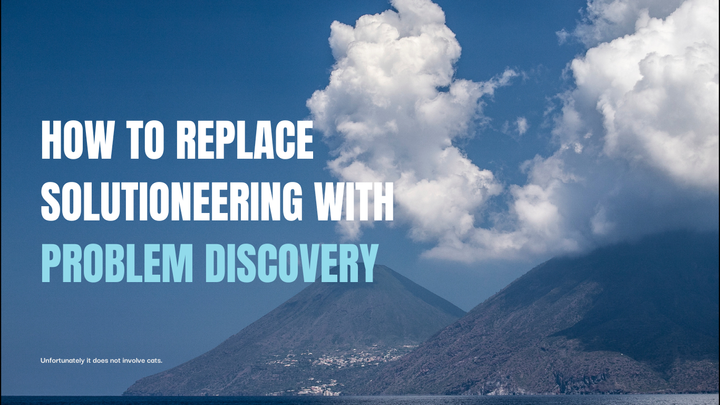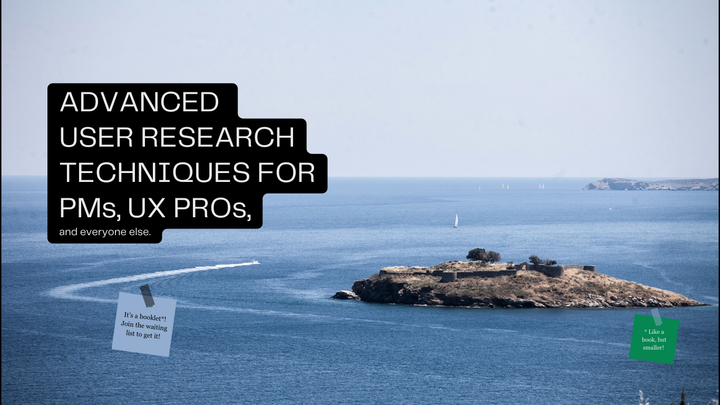Why Are Workshops Great for Product Roadmaps?
This article outlines why workshopping is unparalleled in creating product roadmaps and how it fosters collaboration, understanding, and innovation.

Developing a product roadmap requires a clear understanding of the problem, collaborative ideation, and prioritisation of solutions. Among various methodologies, workshopping stands out as the most effective approach.
This article outlines why workshopping is unparalleled in creating product roadmaps and how it fosters collaboration, understanding, and innovation.
Workshopping is a great methodology for developing a product roadmap because it integrates diverse perspectives, fosters collaboration, and promotes data-driven decision-making. Workshops ensure that product roadmaps are innovative and practical, aligned with user needs and business goals by systematically understanding the problem and collaboratively generating and prioritising solutions. Taking this approach will undoubtedly lead to more successful and well-received products.
Understanding the Problem
As such, the basis of this article is problem definition. We start from the premise that we know what we’re trying to solve and go through all the steps to determine what the problem truly is. How to do that is a whole other story for a later time.
The next step in developing a product roadmap is to thoroughly identify why it needs solving, and the priority it holds. Workshops excel at this stage by bringing together stakeholders, product managers (PMs), UX designers, and engineers to discuss, clarify the problem, understand the goal and prioritise it. That way all participants gain a comprehensive understanding, ensuring alignment from the start.
A great solution to the wrong problem (or worse, a nonexistent problem) is completely useless.
The Advantages of Workshopping
- Inspires Collaboration: Workshops bring together diverse stakeholders, ensuring that everyone knows what they are working on and why. This collective effort fosters a sense of shared purpose and ownership.
- Builds Common Understanding: By collaboratively discussing and clarifying problems, workshops create a shared understanding among participants. This common ground is crucial for effective problem-solving.
- Encourages Contributions: Participants feel valued and are more likely to contribute their ideas when they are actively involved in the process. This inclusive approach leads to richer and more innovative solutions.
- Promotes a Common Mindset: Group settings help in aligning perspectives, making it harder to make bad decisions. Collective decision-making tends to be more balanced and well-considered.
- Relies on Data and Research: Foundational workshops are based on existing knowledge and research, ensuring that the solutions considered are grounded in reality and data-driven.
- Stimulates Research of Solutions: Workshops naturally lead to the exploration and research of proposed solutions, helping to identify the most viable options.
- Involves Engineering Early: By including engineers from the start, workshops reduce the risk of idealistic but impractical solutions. This early involvement ensures technical feasibility is considered throughout the process.
How to do it?
Once the problem is clearly defined, the next step is figuring out how to solve it. This is where workshops truly shine. Workshops leverage the collective insights and expertise of diverse participants, fostering a collaborative environment.
Build a Product Roadmap using the existing knowledge
Leverage the existing user research to draft a product roadmap. Using the insights collected in the past 6 months and applying best practices we can turn the user insights into product requirements.
To avoid miss-alignment of priorities and strategies, stakeholders must be involved from the kick-off to support and validate the roadmap.
How do we build the roadmap?
- What: Define & understand the problem statements to get to the core issues. UX, product, tech, and stakeholders to understand and better define the core problems.
- How: Discovery workshop focused on Problem Definition
- What: Align on the right solution, validated by tech & business stakeholders (UX, PM). Find the right solutions & prioritize them – with tech being part of the exercise from the get-go.
- How: Stakeholders are invited to attend the prioritization workshop to gain alignment and a clear understanding of what we’re doing.
- What: Build the product roadmap with the solutions, after validated and acknowledged by stakeholders.
- How: Create a detailed plan for the development of this solution including timelines, requirements, and key milestones.
- Document & work with product artifacts in Jira
- Epics
- User Stories
- PRDs
- Document & work with product artifacts in Jira
Here’s a structured methodology to follow:
- Set Up the Workshop:
- Board Setup: Use a board to display the problem, context and How Might We.
- Discussion: Engage participants in discussing and understanding the problem.
- Clarification: Ensure everyone has a clear grasp of the issue before moving on.
Here’s a short and cute explanation on how to write a How Might We question:
- Generate Solutions:
- "How Might We" Statements: Use HMW as the guide for solution generation
- Idea Generation: Have participants write down ideas on sticky notes, one idea per note.
- Grouping and Voting: Group similar ideas and have participants rank them using a voting system (each person gets three votes).
- Prioritization and Research:
- Top Ideas: Identify the top ideas based on votes.
- Feasibility Research: Research the feasibility of these ideas.
- Roadmap Creation: Develop a roadmap based on researched and prioritized ideas.
This process not only generates a wealth of innovative solutions but also ensures that the ideas are grounded in practical considerations and aligned with the overall vision.
Guidelines for Effective Workshops
Effective workshops require careful planning and execution. Here are some guidelines based on insights from NN/g (Nielsen Norman Group):
Types of Exercises
In an ideation workshop, you’ll engage in various exercises designed to address different aspects of the product development process. Here are the primary types of exercises and how they can be used in the context of developing a product roadmap:
- Discovery Exercises:
- Purpose: Align the team on overall goals and gather essential information about the problem.
- Activities: Brainstorming and affinity diagramming to collect and organize insights from stakeholders.
- Outcome: A shared understanding of the problem and the objectives of the product.
- Empathy Exercises:
- Purpose: Shift focus to user needs and build empathy for the users.
- Activities: Role-playing and storyboarding to visualize user experiences and challenges.
- Outcome: Insights into user needs and pain points, which inform the design process.
- Design Exercises:
- Purpose: Generate a wide range of ideas and refine them collaboratively.
- Activities: Design studios and forced ranking to brainstorm, evaluate, and prioritize ideas.
- Outcome: A collection of innovative ideas that are feasible and aligned with user needs.
- Prioritization Exercises:
- Purpose: Decide on the most critical features and tasks to shape the product roadmap.
- Activities: Forced ranking and affinity diagramming to prioritize features based on impact and feasibility.
- Outcome: A prioritized list of features and tasks to guide the product development process.
Creating Ground Rules
Establishing ground rules is essential to ensure a productive and respectful workshop environment. Here’s how to set effective ground rules:
- Example Ground Rules:
- Punctuality: Arrive on time to respect everyone’s schedule.
- No Disturbances: Avoid side conversations, announce if you will be BRB or AFK.
- Respect Others: Listen actively and avoid interrupting.
- Participation: Encourage everyone to contribute and ensure all voices are heard.
- Agree to Disagree: Maintain a non-judgmental environment and value all opinions.
- Ask Questions: Emphasize that there are no stupid questions.
- Give Honest Feedback: Provide constructive feedback to improve future sessions.
Conducting Exercises
Effective execution of workshop exercises involves three key steps: Explain, Execute, and Examine. Each step plays a crucial role in ensuring the success of the workshop.
- Explain:
- Introduction: Start with a brief explanation of the activity, its purpose, and the steps involved.
- Context: Discuss the importance of the activity and its relevance to the project.
- Clarify Roles: Define roles if necessary, ensuring everyone knows their responsibilities.
- Execute:
- Facilitator’s Role: Stay available to guide and assist but avoid dominating the activity. Encourage participants to take ownership of the process.
- Track Time: Announce key time points to keep the activity on schedule.
- Examine:
- Present Outcomes: Let participants showcase their work and discuss the results.
- Reflect: Ask reflective questions to synthesize learning and identify key insights.
- Connect: Relate the activity’s outcomes to the overall project goals and subsequent steps.
Practical Tips for Product Managers
- Engage Stakeholders Early: Involve key stakeholders from the beginning to ensure their insights and expectations are considered.
- Foster an Inclusive Environment: Encourage participation from all team members, valuing diverse perspectives.
- Stay User-Centered: Always keep the focus on the user needs and how the product will address their pain points.
- Be Flexible and Adaptive: Be prepared to adjust the workshop agenda based on the dynamics and feedback from participants.
- Document Everything: Keep detailed notes and records of the workshop outcomes to inform the next steps and decisions.
For product managers looking to enhance their roadmapping and collaboration skills, adopting workshopping methodologies is a step in the right direction. The positive, inclusive, and structured nature of workshops makes them an indispensable tool in the product development arsenal.
Learn all about workshopping on NNg:







